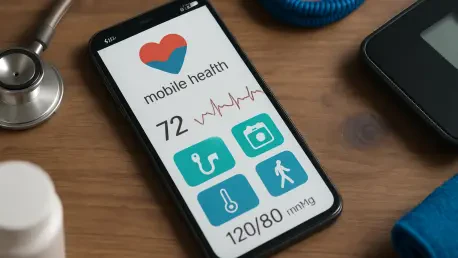The mobile health (mHealth) sector is rapidly transforming the healthcare landscape, harnessing the power of mobile devices and wireless technologies to redefine how medical care is delivered and accessed. Encompassing a wide array of tools like health apps, wearable devices, remote patient monitoring systems, and telemedicine platforms, mHealth is breaking down traditional barriers, making healthcare more personalized and accessible than ever before. With a strong Compound Annual Growth Rate (CAGR) projected through 2035, this market is drawing significant interest from tech giants, healthcare providers, and innovators eager to capitalize on its potential. This surge is driven by a combination of technological advancements, societal needs, and the urgent demand for cost-effective solutions in an era of rising healthcare challenges. As the world becomes increasingly connected, mHealth stands poised to address critical gaps in care delivery, offering a glimpse into a future where health management is just a tap away.
Technological Innovations Fueling Market Expansion
The mHealth market is experiencing a remarkable wave of innovation, propelled by cutting-edge technologies such as artificial intelligence (AI) and the Internet of Things (IoT), which are enhancing the functionality of mobile health tools. Wearable devices have evolved far beyond simple fitness trackers, now playing a crucial role in monitoring chronic conditions like diabetes and hypertension with real-time data. These advancements empower individuals to actively manage their health, reducing the need for frequent hospital visits. Telemedicine, meanwhile, has seen explosive growth, particularly following global health crises that highlighted the necessity of virtual care. This technology enables patients in remote areas to consult with specialists without the burden of travel, easing pressure on overburdened healthcare facilities. As these tools become more sophisticated, their integration into daily life signals a shift toward proactive, rather than reactive, health management.
Another key driver of growth lies in the strategic moves by industry leaders like Apple, Google, and Samsung, who are pushing the boundaries of what mHealth can achieve. Through innovative product launches and partnerships, these companies are setting new standards for health tech, from smartwatches that detect irregular heart rhythms to apps that offer mental health support. The rising prevalence of chronic diseases, coupled with an aging global population, further underscores the need for continuous monitoring solutions that mHealth provides. With healthcare costs soaring, the affordability and scalability of mobile solutions make them an attractive option for both providers and patients. The projected strong CAGR through 2035 reflects confidence in these technologies to address pressing needs, though sustained investment in research and development remains essential to maintain this momentum and tackle emerging challenges in the field.
Global Adoption and Regional Variations
Geographically, the adoption of mHealth solutions paints a diverse picture across the globe, with distinct regional strengths and challenges shaping market dynamics. North America and Europe stand at the forefront, benefiting from robust digital infrastructure and widespread acceptance of mobile health tools among both consumers and healthcare professionals. High smartphone penetration, coupled with supportive policies, has accelerated the integration of telemedicine and wearable devices into mainstream care in these regions. Governments and private sectors alike are investing heavily in digital health initiatives, recognizing the potential to reduce costs and improve patient outcomes. This leadership position, however, comes with the responsibility to set global standards for data security and interoperability, ensuring that innovations benefit users worldwide without compromising trust or safety.
In contrast, regions like Asia Pacific and Latin America are emerging as hotbeds of opportunity, despite facing hurdles related to economic disparities and inconsistent infrastructure. Rapidly increasing smartphone usage in these areas, paired with government efforts to promote digital health, is driving gradual but promising growth. For instance, mobile apps are becoming vital tools for health education in rural communities where access to doctors is limited. Yet, the pace of adoption remains slower due to challenges such as unreliable internet connectivity and varying levels of digital literacy among populations. The untapped potential in these markets is immense, with the right investments and policy frameworks capable of unlocking significant expansion. Bridging these regional gaps will be critical to ensuring that the benefits of mHealth are equitably distributed, particularly in underserved areas hungry for accessible healthcare solutions.
Navigating Challenges in a Growing Industry
Despite the optimistic outlook, the mHealth sector faces substantial challenges that could temper its trajectory if not addressed thoughtfully. Data privacy stands out as a paramount concern, given the sensitive nature of health information handled by mobile platforms. Compliance with stringent regulations like the Health Insurance Portability and Accountability Act (HIPAA) in the U.S. and the General Data Protection Regulation (GDPR) in Europe is mandatory, requiring companies to invest heavily in secure systems that protect user data from breaches. Public trust hinges on these safeguards, as any misstep could undermine confidence in digital health tools. Beyond security, ethical questions about constant health monitoring and the potential for data misuse add layers of complexity, necessitating transparent practices and robust consumer education to mitigate fears and build acceptance.
Additionally, integrating mHealth solutions into existing healthcare frameworks presents logistical difficulties for providers accustomed to traditional models of care. Ensuring seamless compatibility between new technologies and legacy systems is no small feat, often requiring significant training and infrastructure upgrades. Meanwhile, intense competition among industry players fuels innovation but also pressures companies to prioritize speed over thorough testing, risking quality or safety. Regulatory landscapes, which vary widely across regions, further complicate global expansion efforts for firms aiming to scale. Addressing these obstacles demands collaboration between tech developers, healthcare providers, and policymakers to create standardized guidelines that balance innovation with accountability. Only through such coordinated efforts can the industry sustain its growth while upholding the highest standards of care and trust.
Shaping the Future of Healthcare Delivery
Reflecting on the journey so far, the mHealth sector has demonstrated resilience and adaptability, overcoming initial skepticism to become a cornerstone of modern healthcare. Technological strides made in recent years have laid a solid foundation, with mobile apps and wearables proving their worth in enhancing patient engagement and outcomes. The rapid pivot to telemedicine during global health challenges showcased the industry’s capacity to respond to urgent needs, while regional disparities highlighted areas where focused efforts are required to ensure inclusivity.
Looking ahead, the path to 2035 calls for actionable strategies to maintain this upward trajectory. Stakeholders must prioritize investments in data security to safeguard user trust, while fostering partnerships that bridge technological and healthcare expertise. Governments and organizations should focus on narrowing digital divides in emerging markets, ensuring that mHealth benefits reach the most vulnerable populations. By addressing regulatory inconsistencies and promoting interoperable systems, the industry can pave the way for a future where mobile health tools are not just supplementary, but integral to delivering equitable, efficient care globally.









